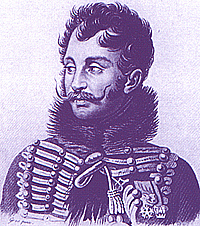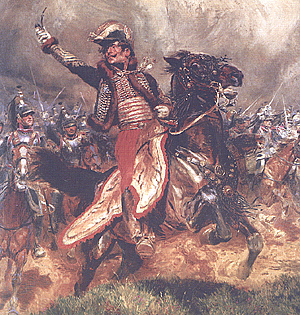Napoleon's Cavalry Commanders
2: General Antoine-Louis-Charles LaSalle
Terry J Senior, (UK)
| |
I suspect the number one choice for many enthusiasts. Like Montbrun, he possessed the ability to read battlefield situations and adapt instantly to tactical changes. Although Montbrun enjoyed the unflinching support of his men, LaSalle was absolutely adored by those under his command. They would have followed him anywhere. As with Montbrun, he led from the front and was a brilliant commander of large formations of cavalry. Usually to be found in the thick of the action he was present at Vicence, Rivoli, the crossing of the Piave, and the Tagliamento, the battle of the Pyramids, Salahieh, Redemieh, Samanhout, Thebes, Djehemali, Vinnadella, Austerlitz, Schliez, Zehdenick, Prentzlow, Stettin, Lubeck, Golymin, Ziegelhoff, Heilsberg, Torquemada, the bridge of Cabezon, Medina del Rio Seco, Burgos, Villa Veijo, Medellin, Essling, Raab, and finally Wagram. He was twice captured, suffered a number of wounds, saved Davout’s life at Redemieh, and received “un sabre et
des pistolets d’honneur on his return to France. In December 1805 he became General de Brigade of the
5e and 7e Hussards which together became known as the “Brigade Infernale”, with Colonels Francois-Xavier Schwarz
and Ferdinand-Daniel Marx as his regimental commanders.
His weakness, especially in his early years was in fact his flamboyance, which time and again verged on the reckless. He worked hard and played hard and before his marriage was a notorious womaniser. Stories abound concerning the lengths he would go to, and the risks he would take to keep a liaison, even crossing behind enemy lines. One of his fellow carousers and closest friends was the infamous, almost uncontrollable, one commentator even suggested mentally unstable, General Francois Fournier-Sarlovese. The two got themselves into, and out, of a whole series of potentially serious and dangerous incidents. Not very tall, he looked every inch a warrior, and was by some distance the best of all the light cavalry commanders. A commander who was known, on occasions, to charge with nothing more than his pipe in his hand, mellowed a little and became more responsible after he married Josephine-Jeanne-Marguerite d’Aiguillon, the divorced wife of General Victor-Leopold Berthier, in 1803. LaSalle possessed a keen sense of duty and responsibility and cared for Berthiers three boys, Almeric-Alexandre, Oscar, and Alexandre-Joseph as if they were his own. He and Josephine-Jeanne had their own little girl, Charlotte-Josephine who was born in May 1806. The loss of LaSalle was very much regretted by the Emperor and many under his command were distraught at the news. Napoleon's Cavalry Commanders
1: General Louis-Pierre Montbrun 2: General Antoine-Louis-Charles LaSalle 3: General Francois-Etienne Kellermann 4: General Jean-Joseph Ange d’Hautpoul 5: General Claude-Pierre Pajol Other CommandersNapoleon's Cavalry Commanders # 6 - # 11
6: General Etienne Marie Antoine Champion de Nansouty 7: General Frederic Louis Henri Walther 8: General Charles Lefebvre Desnouettes 9: General Nicolas Dahlmann 10: General Pierre David (Eduoard) Colbert de Chabanais 11: General Marie Victor Nicolas de Fay Latour Maubourg Napoleon's Cavalry Commanders # 12 - # 14
12: General Claude-Etienne Guyot 13: General Auguste-Francois-Marie de Colbert-Chabanais 14: General Jean-Pierre-Joseph Bruyere Napoleon's Cavalry Commanders # 15 - # 17
15: General Jean-Louis-Brigitte d’Espagne 16: General Louis Lepic 17: General Hippolyte-Marie-Guillaume de Rosnyvinen Comte de Pire Napoleon's Cavalry Commanders # 18 - # 20
18: General Francois Fournier-Sarlovese 19: General Louis-Michel Letort 20: General Edouard-Jean-Baptiste Milhaud Bibliography Back to Table of Contents -- First Empire #66 Back to First Empire List of Issues Back to MagWeb Master Magazine List © Copyright 2002 by First Empire. This article appears in MagWeb (Magazine Web) on the Internet World Wide Web. Other military history articles and gaming articles are available at http://www.magweb.com |

 Following his successes at Zehdenick and then Prentzlow, and with only his brigade (some 900 sabres) present, he accepted
the surrender without a shot being fired, of the fortress of Stettin, with over 5,000 prisoners and 280 artillery pieces.
He was the complete cavalry commander and especially adept at reading the contours of the ground over
which he was expected to charge. He had no fear of death or mutilation. Indeed, he was famously quoted
as saying that a respectable hussar should not expect to live beyond the age of 30. He was in fact 34 when
he was killed at Wagram in July of 1809, shot through the forehead, he was dead before his body
hit the ground.
Following his successes at Zehdenick and then Prentzlow, and with only his brigade (some 900 sabres) present, he accepted
the surrender without a shot being fired, of the fortress of Stettin, with over 5,000 prisoners and 280 artillery pieces.
He was the complete cavalry commander and especially adept at reading the contours of the ground over
which he was expected to charge. He had no fear of death or mutilation. Indeed, he was famously quoted
as saying that a respectable hussar should not expect to live beyond the age of 30. He was in fact 34 when
he was killed at Wagram in July of 1809, shot through the forehead, he was dead before his body
hit the ground.